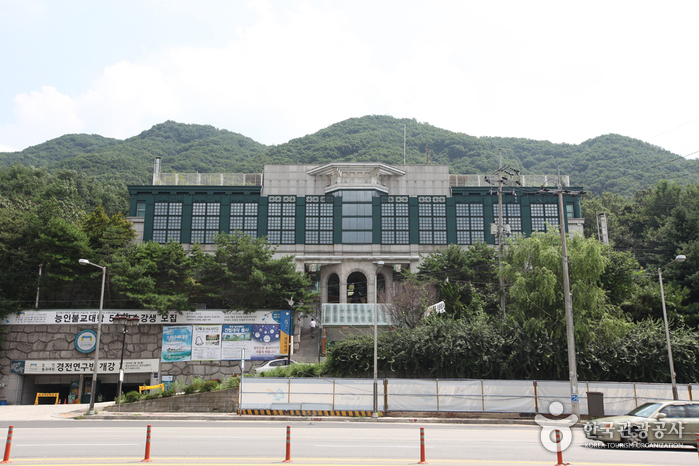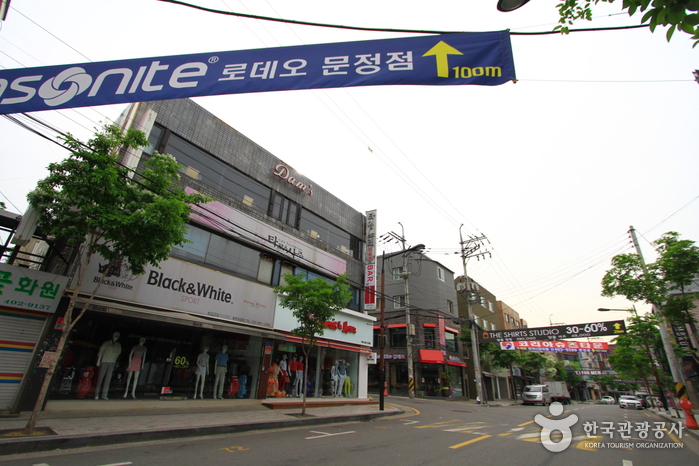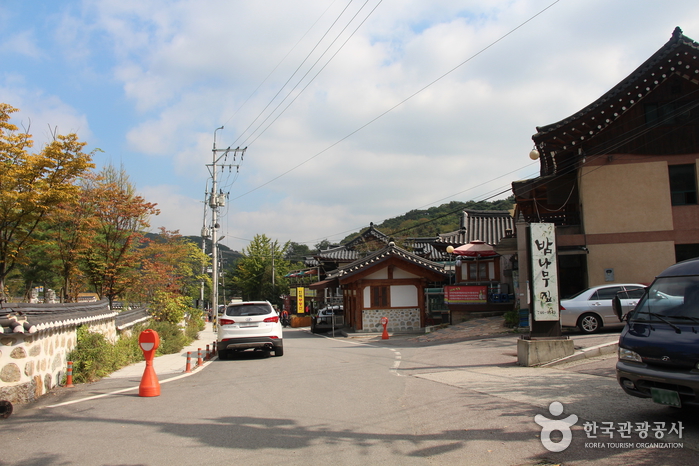Nungin Sunwon (능인선원)
11.5Km 2024-03-20
340 Yangjae-daero, Gangnam-gu, Seoul
Nungin Sunwon, nestled at the base of Guryongsan Mountain, is named after another name of Buddha, Sakyamuni, signifying "the one who skillfully educates and benefits others." This temple complex includes several key structures: the Daeungjeon Hall, the Dharma Hall, the Gwaneumjeon Hall, and the resplendent Great Bhaisajyaguru, known for its golden glow. Additionally, the site houses a Buddhist university, providing a range of programs that cover basic to advanced Buddhist studies.
Olive Young - Irwon Station Branch [Tax Refund Shop] (올리브영 일원역)
11.6Km 2024-04-18
Store #114, 115, Irwon-ro, Gangnam-gu, Seoul
-
Munjeong-dong Rodeo Street (문정동 로데오거리)
11.6Km 2025-03-29
10, Dongnam-ro 4-gil, Songpa-gu, Seoul
+82-2-400-1633
Munjeong-dong Rodeo Street is a large shopping district containing over 200 brand-name discount stores. The street is T-shaped, with a 1-kilometer-long main street connected to a 400-meter-long alley, and the Munjeong 1-dong Resident Center located at the center. For shoppers’ convenience, there is a public parking lot (if visitors purchase goods at Rodeo Street, they can park here for free) and a parking lot for foreign tourists only (free of charge). Munjeong-dong Rodeo Street is one of Korea’s major shopping streets with customers ranging from teenagers to adults, since discount stores stocking sports wear, casual wear, shoes, men’s and ladies’ suits, and golf wear are all located on this street. Moreover, this is a great place to find deals on famous brands, at prices lower than at a department store. On some items you can get discounts of up to 70-80%.
Since most of the goods are stock from previous seasons, it might be better to purchase the more classic styles rather than the trendy fashions. In some cases, the goods might have been slightly crumpled or stained during the transfer from warehouse storage, but taking them to the dry-cleaners should fix most problems. However you should be careful when looking at the sewing quality, and check for missing buttons.
One more thing to bear in mind is the shopping season. Even discount stores have periods when stock runs low. The best time to shop is immediately after the stores in Rodeo Street restock their merchandise. This is done at about the same time as department stores. There is also an enormous variety of goods to choose from during the Rodeo Festivals in May and September. The purchased goods are exchangeable but non-refundable, so check the quality of the products carefully before purchasing.
In addition, Munjeong-dong Rodeo Street has a wide selection of restaurants and entertainment facilities. There are a number of pizza places, coffee shops, and food courts, as well as internet cafes and game rooms in the alleys behind the stores. Visitors can also relax in the surrounding parks. There’s a park with a 600-year-old zelkova tree right behind the Munjeong 1-dong Resident Center.
Munjeong Rodeo Street is not just a shopping district; it’s a cultural area. The ‘Munjeong-dong Cultural Festival’ takes place every year in May, and the ‘Munjeong-dong Rodeo Festival’ takes place in May every other year. During these festivals, visitors can watch traditional Korean performances, traditional wedding ceremonies, international fashion parades, hip-hop dancing, and more.
A charity sale is held on weekends and national holidays on the open-air stage of the Munjeong 1-dong Resident Center, and merchandise is sold for even bigger discounts.
JDX - Munjeong Branch [Tax Refund Shop] (JDX 문정)
11.6Km 2024-04-18
96, Dongnam-ro, Songpa-gu, Seoul
-
Dongbaekgung Dongbaek Branch (동백궁 동백점)
11.6Km 2024-02-28
489 Dongbaekjukjeon-daero, Giheung-gu, Yongin-si, Gyeonggi-do
Dongbaekgung, featuring a traditional hanok interior, specializes in dwaeji galbi gui (grilled pork galbi) and sogalbi gui (grilled galbi). Their standout dishes are yangnyeom galbi gui (grilled marinated galbi) and saenggalbi gui (grilled galbi). The menu also includes a la carte items such as galbitang (galbi soup), yukhoe bibimbap (beef tartare bibimbap), and Hamheung naengmyeon (Hamheung cold buckwheat noodles). A popular lunch choice is the sutbul hanjeongsik (Korean table d'hote with charcoal-grilled dish), which includes hot pot rice and a selection of grilled dishes like jumulleok (spicy stir-fried pork), yangnyeom galbi (grilled marinated galbi), and saenggalbi (galbi).
Olive Young - Yongin Gugal Branch [Tax Refund Shop] (올리브영 용인구갈)
11.7Km 2024-04-19
Store #101, 64, Gugal-ro, Giheung-gu, Yongin-si, Gyeonggi-do
-
E-Mart - Yangjae Branch [Tax Refund Shop] (이마트 양재)
11.7Km 2024-04-22
16, Maeheon-ro, Seocho-gu, Seoul
-
Namhansanseong Provincial Park [UNESCO World Heritage] (남한산성도립공원 [유네스코 세계문화유산])
11.7Km 2024-02-29
731 Namhansanseong-ro, Namhansanseong-myeon, Gwangju-si, Gyeonggi-do
+82-31-746-1088
Namhansanseong was a fortress that protected the southern approaches to the capital during the Baekje kingdom (18 B.C. – 660 A.D.) and the Joseon dynasty (1392-1897). During the Qing invasion of Joseon in 1636, King Injo of Joseon (reigned 1623-1649) sought refuge here and constructed Haenggung, a temporary palace. Subsequently, it became the administrative center of the Gwangju region, and today, it is a site where many cultural properties are preserved.
Traditional Food Town around Namhansanseong Fortress (남한산성 전통음식마을)
11.7Km 2021-03-17
731, Namhansanseong-ro, Gwangju-si, Gyeonggi-do
+82-31-762-3010
The Traditional Food Town around Namhansanseong Fortress has many restaurants offering rice, dotorimuk (acorn jelly salad), tojongdak (whole chicken) dishes, and other traditional dishes. The area embraces almost 300 years of Korean history and the restaurants were built in traditional hanok-style buildings around Namhansanseong Fortress, a military stronghold from the Joseon dynasty.

![Olive Young - Irwon Station Branch [Tax Refund Shop] (올리브영 일원역)](http://tong.visitkorea.or.kr/cms/resource/54/2889454_image2_1.jpg)


![Olive Young - Yongin Gugal Branch [Tax Refund Shop] (올리브영 용인구갈)](http://tong.visitkorea.or.kr/cms/resource/20/2889420_image2_1.jpg)
![E-Mart - Yangjae Branch [Tax Refund Shop] (이마트 양재)](http://tong.visitkorea.or.kr/cms/resource/89/2889589_image2_1.jpg)
![Namhansanseong Provincial Park [UNESCO World Heritage] (남한산성도립공원 [유네스코 세계문화유산])](http://tong.visitkorea.or.kr/cms/resource/56/2612856_image2_1.jpg)

 English
English
 한국어
한국어 日本語
日本語 中文(简体)
中文(简体) Deutsch
Deutsch Français
Français Español
Español Русский
Русский